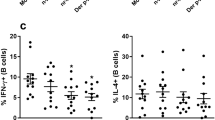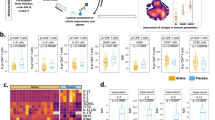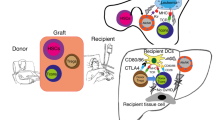Abstract
Atopy is excessive production of IgE in response to allergens. We evaluated in patients undergoing allogeneic hematopoietic cell transplantation (HCT) the following hypotheses: (1) Atopy is “curable” in atopic patients receiving HCT from a nonatopic donor (D-R+), and (2) Atopy is transferable from atopic donors to nonatopic recipients (D+R-). Atopic patients with atopic donors (D+R+) and non-atopic patients with non-atopic donors (D-R-) served as controls. We measured levels of multiallergen-specific IgE (A-IgE, atopy defined as ≥0.35 kUA/L) in sera from 54 patients and their donors pre HCT and from the patients at ≥2 years post HCT. Only 7/12 (58%) D− R+ patients became nonatopic after HCT. Only 1/11 (9%) D+R- patients became atopic. Eleven of 13 (85%) D-R- patients remained nonatopic. Unexpectedly, 11/18 (61%) D+R+ patients became nonatopic. In conclusion, contrary to our hypothesis and previous reports, the “cure” of atopy may occur in only some D-R+ patients and the transfer of atopy may occur rarely. The “cure” may not be necessarily due to the exchange of atopic for nonatopic immune system, as the “cure” may also occur in D+R+ patients.
This is a preview of subscription content, access via your institution
Access options
Subscribe to this journal
Receive 12 print issues and online access
$259.00 per year
only $21.58 per issue
Buy this article
- Purchase on Springer Link
- Instant access to full article PDF
Prices may be subject to local taxes which are calculated during checkout


Similar content being viewed by others
Change history
17 April 2020
The original version of this Article was updated shortly after publication to correct the typo in the title where ‘Curability’ was misspelled as ‘Curtability. The update does not impact on the scientific content of the article. This has now been corrected in both the PDF and HTML versions of the Article.
20 May 2020
The original version of this Article was updated shortly after publication for minor correction on the legend of supplementary figure 9. The update does not impact on the scientific content of the article.
References
Szefler SJ, Wenzel S, Brown R, Ezurum SC, Fahy JV, Hamilton RG, et al. Asthma outcomes: biomarkers. J Allergy Clin Immunol. 2012;129:S9–23.
Thomsen SF. Epidemiology and natural history of atopic diseases. Eur Clin Respir J. 2015;2. https://doi.org/10.3402/ecrj.v2.24642.
Adkinson NF, Yunginger JW, Busse WW, Bochner BS, Holgate ST, Simons FER. Middleton’s allergy. Philadelphia: Mosby; 2003.
Foley SC, Prefontaine D, D’Antoni M, Hamid Q. Images in allergy and immunology: regulatory T cells in allergic disease. J Allergy Clin Immunol. 2007;120:482–6.
Hartl D, Koller B, Mehlhorn AT, Reinhardt D, Nicolai T, Schendel DJ, et al. Quantitative and functional impairment of pulmonary CD4+CDS5hi regulatory T cells in pediatric asthma. J Allergy Clin Immunol. 2007;119:1258–66.
Hackett TL, Knight DA. The role of epithelial injury and repair in the origins of asthma. Curr Opin Allergy Clin Immunol. 2007;7:63–8.
Walker SA, Riches PG, Wild G, Ward AM, Shaw PJ, Desai S, et al. Total and allergen-specific IgE in relation to allergic response pattern following bone marrow transplantation. Clin Exp Immunol. 1986;66:633–9.
Bellou A, Kanny G, Fremont S, Moneret-Vautrin DA. Transfer of atopy following bone marrow transplantation. Ann Allergy Asthma Immunol. 1997;78:513–6.
Saarinen UM. Transfer of latent atopy by bone marrow transplantation? A case report. J Allergy Clin Immunol. 1984;74:196–200.
Tucker J, Barnetson RSC. Atopy after bone marrow transplantation. Brit Med J. 1985;290:116–7.
Smith SR, MacFarlane AW, Lewis-Jones MS. Papular urticaria and transfer of allergy following bone marrow transplantation. Clin Exp Dermatol. 1988;13:260–2.
Yong PF, Grosse-Kreul D, Devereux S, Pagliuca A, Maher J, Ibrahim MA. Increase in allergy following donor lymphocyte infusions. Bone Marrow Transpl. 2006;37:983–4.
Agosti JM, Sprenger JD, Lum LG, Witherspoon RP, Fisher LD, Storb R, et al. Transfer of allergen-specific IgE-mediated hypersensitivity with allogeneic bone marrow transplantation. N. Engl J Med. 1988;319:1623–8.
Hinterberger W, Hinterberger-Fischer M, Marmont A. Clinically demonstrable anti-autoimmunity mediated by allogeneic immune cells favorably affects outcome after stem cell transplantation in human autoimmune diseases. Bone Marrow Transpl. 2002;30:753–9.
Wahn V, Laws HJ, Bode CP, Burdach SE. Cure of latex allergy by bone marrow transplantation. Eur J Pediatr. 1999;158:88.
Koharazawa H, Kanamori H, Takabayashi M, Yamaji S, Taguchi J, Fujimaki K, et al. Resolution of atopic dermatitis following allogeneic bone marrow transplantation for chronic myelogenous leukemia. Bone Marrow Transpl. 2005;35:1223–4.
Hourihane JO, Rhodes HL, Jones AM, Veys P, Connett GJ. Resolution of peanut allergy following bone marrow transplantation for primary immunodeficiency. Allergy. 2005;60:536–7.
Zeng G, Hu H, Zheng P, Wu G, Wei N, Liang X. The practical benefit of Phadiatop test as the first-line in vitro allergen-specific immunoglobulin E (sIgE) screening of aeroallergens among Chinese asthmatics: a validation study. Ann Transl Med. 2018;6:151.
Cantani A, Ferrara M, Barbieri C, Monteleone A, Businco L. Evaluation of new test (Phadiatop) for the screening of respiratory allergic disorders in children. Ann Allergy. 1990;64:158–61.
Hwang H, Kwon J, Kim JY, Lee HH, Oh CE, Choi GS. The RIDA allergy screen versus the phadiatop test in 430 consecutive patient specimens. Lab Med. 2016;47:20–9.
Heyd J, Donnenberg AD, Burns WH, Saral R, Santos GW. Immunoglobulin E levels following allogeneic, autologous, and syngeneic bone marrow transplantation: an indirect association between hyperproduction and acute graft-v-host disease in allogeneic BMT. Blood. 1988;72:442–6.
Brenner MK. Recovery of Ig isotypes following T cell depleted allogeneic bone marrow transplantation. Brit J Haematol. 1986;64:25.
Ringden O. Markedly elevated serum IgE levels following allogeneic and syngeneic bone marrow transplantation. Blood. 1983;61:1190.
Bosch M, Khan F, Storek J. Immune reconstitution after hematopoietic cell transplantation. Curr Opin Hematol. 2012;19:324–35.
Burt RK, Traynor A, Statkute L, Barr WG, Rosa R, Schroeder J, et al. Nonmyeloablative hematopoietic stem cell transplantation for systemic lupus erythematosus. JAMA. 2006;295:527–35.
Tsukamoto H, Nagafuji K, Horiuchi T, Mitoma H, Niiro H, Arinobu Y. Analysis of immune reconstitution after autologous CD34+ stem/progenitor cell transplantation for systemic sclerosis: predominant reconstitution of Th1 CD4+ T cells. Rheumatology. 2011;50:944–52.
Swart JF, Delemarre EM, van Wijk F, Boelens JJ, Kuball J, van Laar JM, et al. Haematopoietic stem cell transplantation for autoimmune diseases. Nat Rev Rheumatol. 2017;13:244–56.
De Amici M, Ciprandi G. The age impact on serum total and allergen-specific IgE. Allergy Asthma Immunol Res. 2013;5:170–4.
Mediaty A, Neuber K. Total and specific serum IgE decreases with age in patients with allergic rhinitis, asthma and insect allergy but not in patients with atopy dermatitis. Immun Ageing. 2005;2:9.
Ulrik CS, Backer V. Atopy in Danish children and adolescents: results from a longitudinal population study. Ann Allergy Asthma Immunol. 2000;85:293–7.
Oryszczyn MP, Annesi I, Neukirch F, Doré MF, Kauffmann F. Longitudinal observations of serum IgE and skin prick test response. Am J Respir Crit Care Med. 1995;151:633–8.
Mohty M. Mechanisms of action of antithymocyte globulin: T-cell depletion and beyond. Leukemia. 2007;21:1387–94.
Leitner J, Grabmeier-Pfistershammer K, Majdic O, Zlabinger G, Steinberger P. Interaction of antithymocyte globulins with dendritic cell antigens. Am J Transpl. 2011;11:138–45.
Storek J, Vliagoftis H, Grizel A, Lyon AW, Daly A, Khan F, et al. Allergy transfer with hematopoietic cell transplantation from an unrelated donor. BMT. 2011;46:605–6.
Luger EO, Fokuhl V, Wegmann M, Abram M, Tillack K, Achatz G, et al. Induction of long-lived allergen-specific plasma cells by mucosal allergen challenge. J Allergy Clin Immunol. 2009;124:819–26.
Mitre E, Nutman TB. IgE memory: persistence of antigen-specific IgE responses years after treatment of human filarial infections. J Allergy Clin Immunol. 2006;117:939–45.
Bhoj VG, Arhontoulis D, Wertheim G, Capobianchi J, Callahan CA, Ellebrecht CT, et al. Persistence of long-lived plasma cells and humoral immunity in individuals responding to CD19-directed CAR T-cell therapy. Blood. 2016;128:360–70.
Griffith LM, McCoy JP Jr, Bolan CD, Stroncek DF, Pickett AC, Linton GF, et al. Persistence of recipient plasma cells and anti-donor isohaemagglutinins in patients with delayed donor erythropoiesis after major ABO incompatible non-myeloablative haematopoietic cell transplantation. Br J Haematol. 2005;128:668–75.
Gerritsen EJA, van Tol MJD, Lankester AC, van der Weijden-Ragas CPM, Jol-van der Zijde CM, Ouderman-Gruber NJ, et al. Immunoglobulin levels and monoclonal gammopathies in children after bone marrow transplantation. Blood. 1993;82:3493–502.
KleinJan A, Vinke JG, Severijnen LW, Fokkens WJ. Local production and detection of (specific) IgE in nasal B-cells and plasma cells of allergic rhinitis patients. Eur Respir J. 2000;15:491–7.
Happel CS, Stone KD, Freeman AF, Shah NN, Wang A, Lyons JJ, et al. Food allergies can persist after myeloablative hematopoietic stem cell transplantation in dedicator of cytokinesis 8-deficient patients. J Allergy Clin Immunol. 2016;137:1895–8.e5.
Slott RI, Zweiman B. A controlled study of the effect of corticosteroids on immediate skin test reactivity. J Allergy Clin Immunol. 1974;54(4):229–34.
Acknowledgements
We are extremely grateful for the dedication of the research nurses including Krista Dyck, Jennifer LeBlanc, Candice Healey, and Polly Louie, and the research coordinators including Mamta Kantharia and Heather Cooper. We wish to thank Cindy Miskolczi-McCallum for her assistance. We also thank the staff of Calgary Laboratory Services including Lori Gervais, Patricia Johnson, and Rhonda Jackson. We thank the Foothills Medical Center leukemia ward nurses headed by Laura Spilchen and Lorraine Harrison. We thank the staff of the CIBMTR (Center for International Blood and Marrow Transplant Research) Research Sample Repository, who provided donor pretransplant specimens on three cases. The study was funded by a grant from Alberta Heritage Foundation for Medical Research, a grant from Calgary Lab Services/Alberta Public Laboratories, and a grant from Buckley Family Foundation.
Funding
The study was funded by a grant from Alberta Heritage Foundation for Medical Research, a grant from Calgary Lab Services/Alberta Public Laboratories, and a grant from Buckley Family Foundation.
Author information
Authors and Affiliations
Contributions
Contribution: SW analyzed the data and wrote the manuscript. AC supervised the A-IgE determination. GT, RD, and AA performed chimerism analysis. PD-K and AK enumerated CD4 T cells. MM, PK, PS, MNG, VL, MM, LL, AD, TVS, JB, and SS facilitated patient accrual and collection of specimens. RL and FMK provided intellectual input. JS designed the study, supervised the analyses and edited the manuscript.
Corresponding author
Ethics declarations
Conflict of interest
The authors declare that they have no conflict of interest.
Additional information
Publisher’s note Springer Nature remains neutral with regard to jurisdictional claims in published maps and institutional affiliations.
Supplementary information
Rights and permissions
About this article
Cite this article
Whiteside, S., Chin, A., Tripathi, G. et al. Curability and transferability of atopy with allogeneic hematopoietic cell transplantation. Bone Marrow Transplant 55, 1282–1289 (2020). https://doi.org/10.1038/s41409-020-0876-7
Received:
Revised:
Accepted:
Published:
Issue Date:
DOI: https://doi.org/10.1038/s41409-020-0876-7



